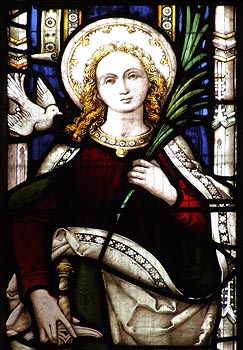 |
 |
|||
|
|
St. Columba was the Cornish
St. Catherine. She was the daughter of a certain
King Lodan, presumably of Gododdin (Lothian), and
Queen Manigilda. She had a vision in which the Holy Spirit
appeared to her in the form of a white dove (Columba also means dove),
promising her blessings and love. She decided to remain a virgin and refrain
from attending the pagan temple with her parents. Shocked at her behaviour,
they had Columba whipped and then thrown in prison. She escaped with the
help of an angel who led her to the desert. Eventually a local king
captured Columba and, admiring her beauty and grace, offered to marry her
to his son, so that they might rule together after his death. Columba
declined the offer and so was tortured on a wheel and thrown into gaol
once more. Again, she escaped with the help of an angel and fled to the
coast where she boarded the first available ship. This took her to
Trevelgvy (Trevelgue Head) in Cornwall, but her prospective father-in-law caught up with
her at Ruthwas (Ruthvoes) and chopped off her head! She was buried at
nearby St. Columb Major. It is not clear from where
Columba is supposed to have originated, or how far she travelled to
Cornwall. The name is Irish, but was popular in Scotland through the works
of St. Columba of Iona. He, of course, was a man, however, and
Baring-Gould suggests that the Cornish saint was really the Irishman, St.
Columba of Ter-da-glas. There is no evidence for this. Her father Lodan
probably represents King Lleuddun alias Lot
Luwddoc of Gododdin, and Manigilda, a corrupt anglicized version
of his wife in Arthurian romance, Queen
Morgause. Columba's feast day is variously given due to confusion
with similarly named saints. The correct date appears to be 11th November.
Records of St. Columba date back to the 13th century. She is generally considered legendary.
|
|||
| © Nash Ford Publishing 2006. All Rights Reserved. | ||||





 St.
Columba the Virgin
St.
Columba the Virgin